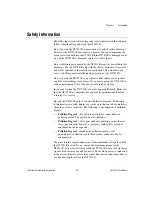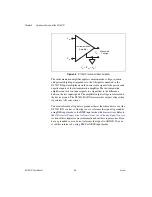
Chapter 2
Hardware Overview of the NI 7831R
2-12
ni.com
You can fully balance the signal path by connecting another resistor of the
same value between the positive input and AIGND, as shown in Figure 2-7.
This fully balanced input mode offers slightly better noise rejection but has
the disadvantage of loading down the source with the series combination
(sum) of the two resistors. If, for example, the source impedance is 2 k
Ω
and each of the two resistors is 100 k
Ω
, the resistors load down the source
with 200 k
Ω
and produce a –1% gain error.
Both inputs of the instrumentation amplifier require a DC path to ground
for the instrumentation amplifier to work. If the source is AC coupled
(capacitively coupled), the instrumentation amplifier needs a resistor
between the positive input and AIGND. If the source has low-impedance,
choose a resistor that is large enough not to significantly load the source but
small enough not to produce significant input offset voltage as a result of
input bias current, typically 100 k
Ω
to 1 M
Ω
. In this case, connect the
negative input directly to AIGND. If the source has high output impedance,
balance the signal path as previously described using the same value
resistor on both the positive and negative inputs. Loading down the source
causes some gain error.
Single-Ended Connection Considerations
When the NI 7831R AI signal is referenced to a ground that can be shared
with other input signals, it forms a single-ended connection. The input
signal connects to the positive input of the instrumentation amplifier and
the ground connects to the negative input of the instrumentation amplifier.
You can use single-ended input connections for any input signal that meets
the following conditions:
•
The input signal is high-level (>1 V).
•
The leads connecting the signal to the NI 7831R are less than
3 m (10 ft).
•
The input signal can share a common reference point with other
signals.
Use DIFF input connections for greater signal integrity for any input signal
that does not meet the preceding conditions.
You can configure in software the NI 7831R channels for RSE or NRSE
input modes. Use the RSE input mode for floating signal sources. In this
case, the NI 7831R provides the reference ground point for the external
signal. Use the NRSE input mode for ground-referenced signal sources. In
this case, the external signal supplies its own reference ground point and the
NI 7831R should not supply one.
















































